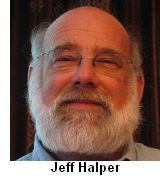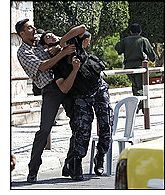 Many times, media outlets and non-governmental organizations (NGOs) rely upon unsourced and uncorroborated Palestinian “eyewitnesses” to back up their stories, despite the unprofessionalism that lies behind this sloppy form of investigation.
Many times, media outlets and non-governmental organizations (NGOs) rely upon unsourced and uncorroborated Palestinian “eyewitnesses” to back up their stories, despite the unprofessionalism that lies behind this sloppy form of investigation.
But what if journalists conveniently left out the real agendas of interviewees who publicly represent extreme agendas? After all, you wouldn’t quote the leader of the Ku Klux Klan on race relations without stating his relationship to the organization.
The Guardian, in an article on an Israeli land expropriation in the West Bank, talks with “Jeff Halper, an Israeli geographer who specialises in Israel’s development of the West Bank”. Yet, reporter Conal Urquhart could not have failed to know of Halper’s role as the public face of the Israel Committee Against House Demolitions.
According to NGO Monitor, ICAHD claims to be “a non-violent, direct-action group … to oppose and resist Israeli demolition of Palestinian houses in the Occupied Territories.” A recipient of EU funding, ICAHD partners with radical NGOs to campaign against the two-state solution, promote the “Durban Strategy” of boycotts and demonizing Israel, using terms such as “apartheid”, and grossly distorting the Israeli-Palestinian conflict.
Regardless of whether or not one agrees with the contents of the article, The Guardian’s readers deserve to know Halper’s agenda and who he represents as opposed to this disingenous portrayal as a “geographer”.
Send your comments to The Guardian – [email protected]
As for the article itself, it deals with a controversial issue and one that does not necessarily command a consensus amongst Israelis themselves. However, in the absence of any substantial official Israeli comment in The Guardian’s piece and elsewhere in the media, see here as to why the issue is not as simple as the media presents it.
WHERE’S THE OUTRAGE?
Imagine the outrage in the international press and beyond:
 “the two parties of the conflict perpetrated grave breaches of the provisions of international law concerning internal armed conflicts, especially common article 3 of the Geneva Conventions of 1949. The fighting included: extra-judicial and willful killings of combatants who laid down their arms; killing a number of wounded persons inside hospitals; abduction and torture; using houses and apartment buildings in the fighting, endangering the lives of civilians; obstruction of access of medical and civil defense crews to areas of clashes…
“the two parties of the conflict perpetrated grave breaches of the provisions of international law concerning internal armed conflicts, especially common article 3 of the Geneva Conventions of 1949. The fighting included: extra-judicial and willful killings of combatants who laid down their arms; killing a number of wounded persons inside hospitals; abduction and torture; using houses and apartment buildings in the fighting, endangering the lives of civilians; obstruction of access of medical and civil defense crews to areas of clashes…
The past 15 months have witnessed several rounds of fighting in the Gaza Strip between the two movements. The fighting has been characterized by grave breaches of human rights and international humanitarian law, including willful killings, abduction and torture. The militants disregarded the lives of civilians when they transformed roof of a number of apartment buildings as sites for them and established barriers in densely populated areas. These places were used in the fighting, thus endangering the lives of civilians.”
This, however, is not a report on Israeli-Palestinian clashes, but intra-Palestinian violence between Hamas and Fatah according to the Palestinian Center for Human Rights. Of course, it would be welcome if Human Rights were universal, applying equally to Israeli victims of those terror groups that the PCHR selectively condemns only when Palestinians are the casualties.

